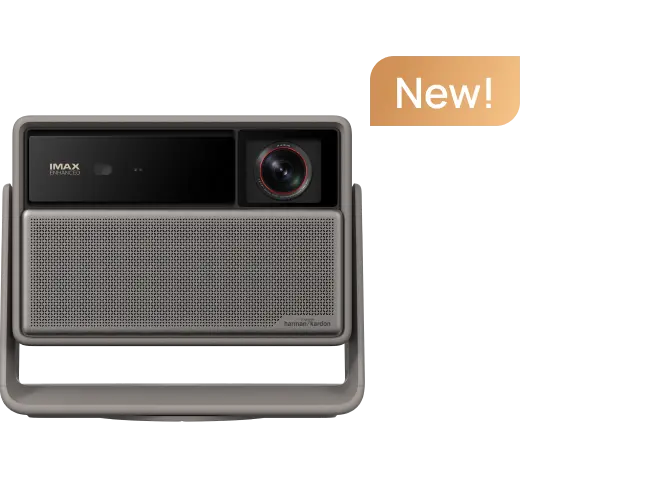Dolby Vision, HDR10+, & HDR10: Elevating Your Viewing Experience
By XGIMI Tech - 2023-12
Introducing HDR Technology
The evolution of television and projector technology has brought cinema-quality visuals to our homes. Central to this transformation is High Dynamic Range (HDR) technology, offering superior image quality and enhanced visual experiences. This article delves into three prominent HDR formats – Dolby Vision, HDR10+, and HDR10, highlighting their distinctions, and ultimately celebrating Dolby Vision, especially when experienced on the remarkable XGIMI HORIZON Ultra projector.
What is HDR?
High Dynamic Range (HDR) is a groundbreaking technology designed to enhance the visual quality of our favorite movies, TV shows, and video games. At its core, HDR is all about improving contrast, color accuracy, and brightness in the content we consume, offering an elevated and more immersive viewing experience.

●HDR Key Components:
1. Increased Contrast: One of the fundamental aspects of HDR is its ability to provide significantly increased contrast ratios. This means deeper blacks and brighter whites within the same image. A higher contrast ratio is crucial for rendering details in both well-lit and shadowed areas of a scene, ultimately delivering more vivid and lifelike visuals.
2. Wider Color Gamut: HDR introduces a broader range of colors than standard dynamic range (SDR) content. The expanded color palette results in more accurate and vibrant color representation, offering a greater spectrum of shades for a more true-to-life experience.
3. Enhanced Brightness: In addition to greater contrast and color depth, HDR content often features increased brightness, or "luminance." This means certain elements in a scene can appear much brighter than with SDR content, leading to visuals that are not only more realistic but also more dynamic and captivating.
It's important to note that not all HDR content or devices are created equal. There are several HDR formats, each with its own specifications, capabilities, and advantages. Understanding these different formats is essential to fully appreciate the nuances of HDR technology. To that end, let's explore the distinctions between HDR10, HDR10+, and Dolby Vision and uncover how each influences your viewing experience.
Differences Between HDR10, HDR10+, and Dolby Vision
As we dive deeper into the world of High Dynamic Range (HDR), it's crucial to understand the specific formats that deliver this technology to our screens. HDR10, HDR10+, and Dolby Vision are three prominent HDR formats, each with its unique characteristics and capabilities. Let's explore how they differ:
1. HDR10
●Format: HDR10, often considered the foundation of HDR, is one of the earliest HDR formats to gain widespread adoption. It was developed to enhance the visual quality of content by increasing its contrast, color accuracy, and brightness.
●Static Metadata: HDR10 uses static metadata, meaning that the parameters for the entire content are set at the beginning and remain the same throughout the entire movie or show. While this can result in improved quality compared to Standard Dynamic Range (SDR) content, it lacks the ability to adjust settings on a scene-by-scene basis.
●Applications: HDR10 is widely supported and can be found in various devices, including TVs and projectors.
2. HDR10+
●Format: HDR10+ builds upon the foundation laid by HDR10 by introducing dynamic metadata. This means that the parameters can be adjusted scene by scene, providing a more accurate and visually appealing experience.
●Dynamic Metadata: Dynamic metadata allows content to be optimized on a frame-by-frame basis, resulting in better contrast, color accuracy, and overall quality.
●Applications: HDR10+ offers improved visuals for supported devices such as TVs and projectors. However, it's not as widely adopted as HDR10.
3. Dolby Vision: The Pinnacle of HDR
●Format: Dolby Vision is often regarded as the pinnacle of HDR technology. It's a premium HDR format developed by Dolby Laboratories, offering advanced dynamic metadata and superior capabilities.
●Dynamic Metadata: Like HDR10+, Dolby Vision uses dynamic metadata to adjust brightness, contrast, and color settings on a frame-by-frame basis. This results in stunning image quality with better brightness control, deeper blacks, and a broader color spectrum.
●Applications: Dolby Vision is the choice for those who demand the highest quality HDR experience. It's found in premium and high-end TVs and projectors, with the XGIMI HORIZON Ultra being the world’s first 4k long-throw home projector with dolby vision. This makes it a standout choice for home theaters and high-end setups.

4. Comparison
To better understand the differences between HDR10, HDR10+, and Dolby Vision, let's delve into a detailed comparison of these High Dynamic Range formats.
| Features | HDR10 | HDR10+ | Dolby Vision |
|---|---|---|---|
| Metadata | It uses static metadata. The tone mapping is the same throughout the entire movie or show, which can lead to scenes not looking as good as they could due to limited adjustments. | This format employs dynamic metadata, allowing for scene-by-scene adjustments to enhance brightness, contrast, and color settings, resulting in better quality. | It also relies on dynamic metadata, providing frame-by-frame adjustments for superior brightness, contrast, and color settings. This ensures an exceptional viewing experience. |
| Supported Devices | Widely supported across various devices, including most TVs and projectors. | While growing in support, it is not as widely adopted as HDR10 and is available on select platforms. | Found in premium and high-end TVs and the XGIMI HORIZON Ultra projector. It's the choice for those who demand top-tier HDR quality. |
| Content Availability | Abundant content is available in HDR10, making it a solid choice for everyday HDR viewing. | Content availability is steadily growing, but it is still not as extensive as HDR10. | Available on select streaming platforms like Netflix and Disney+, offering a range of premium content to fully utilize your projector's capabilities. |
| Color Depth | Utilizes a 10-bit color depth. | Also uses a 10-bit color depth. | Stands out with a 12-bit color depth, supporting over 68 billion colors for more accurate and vibrant visuals. |
| Maximum Brightness | Offers up to 1,000 nits of brightness. | Can reach up to 4,000 nits of brightness. | Leads the way with up to 10,000 nits of brightness, providing stunningly vivid and lifelike images. |
| Overall Quality | Provides good quality but lacks the frame-by-frame optimization found in dynamic HDR formats. | Offers improved quality thanks to dynamic metadata adjustments. | Stands out as the premium choice, providing superior quality with frame-by-frame adjustments, vibrant colors, and incredible brightness. |
| Tone Mapping | The use of static metadata limits tone mapping, resulting in scenes that may not look as good as they could. | Dynamic metadata allows for scene-specific tone mapping adjustments, improving image quality. | Like HDR10+, Dolby Vision uses dynamic metadata to optimize tone mapping on a frame-by-frame basis, ensuring the best possible image quality. |
In this comprehensive comparison, Dolby Vision emerges as the clear winner, offering the highest quality HDR experience with dynamic metadata, a broader color gamut, exceptional brightness, and superior overall quality.
Advantages of using Dolby Vision on projectors
Dolby Vision, known for its advanced dynamic metadata, offers a transformative viewing experience when integrated with projectors.

Here are the key advantages of using Dolby Vision on projectors:
1. Enhanced Picture Quality:
Dolby Vision's dynamic metadata allows for precise adjustments of brightness, contrast, and color settings on a frame-by-frame basis. This results in stunning image quality with impeccable brightness control, deeper blacks, and a wider color spectrum. On projectors, this means more lifelike and vibrant visuals, making it ideal for home theaters and high-end setups.
2. Greater Image Depth:
Dolby Vision's dynamic metadata optimization extends to the depth of the image. It preserves subtle details and nuances in the content, enhancing the perception of depth and realism. This depth adds to the immersive quality of the viewing experience.
3. Wider Color Gamut:
Dolby Vision supports a wide color gamut with 12-bit color depth, allowing it to reproduce over 68 billion colors. This results in more accurate and vibrant colors, especially when projecting content with rich and varied color palettes. Whether you're watching nature documentaries or visually stunning films, the wider color gamut ensures a more vivid and true-to-life color representation.
4. Enhanced Contrast:
Dolby Vision projectors offer exceptional contrast ratios, displaying deeper blacks and brighter whites simultaneously. This enhances the realism of the projected images. It's particularly noticeable in dark scenes, where the richness of the blacks and the impact of bright scenes are significantly heightened.
5. High Brightness Levels:
Dolby Vision projectors can deliver high brightness levels, often reaching up to 10,000 nits. This ensures content appears exceptionally bright and vivid, making it suitable for various viewing environments, including well-lit rooms.
6. Premium Content Support:
Many streaming platforms, including Netflix and Disney+, offer content in Dolby Vision. This means that you can access a wide selection of premium content to fully utilize your projector's capabilities.
How to enjoy content with Dolby Vision
Dolby Vision is a cutting-edge technology that enhances the quality of video content by providing advanced dynamic metadata to compatible displays. To enjoy Dolby Vision, you need a compatible device, and it's not limited to just televisions. Here's how you can watch Dolby Vision content:
1. TV:
Many high-end and newer television models support Dolby Vision. To experience Dolby Vision on your TV, ensure that it's a Dolby Vision-enabled model and that the content you're watching, such as movies or series, is offered in Dolby Vision. Major streaming platforms like Netflix and Disney+ offer a wide range of content in Dolby Vision.
2. XGIMI HORIZON Ultra Projector:
When it comes to projectors, the XGIMI HORIZON Ultra stands out as the world’s first 4k long-throw home projector with dolby vision. This projector provides an exceptional Dolby Vision experience on a large screen.

The advantages of using the XGIMI HORIZON Ultra for Dolby Vision content are noteworthy:
●Ultra-High Brightness: With 2300 ISO lumens, the XGIMI HORIZON Ultra ensures that Dolby Vision content is displayed with exceptional brightness.
●Ultra-Wide Color Gamut: It boasts a color gamut that covers DCI-P3 at 95.5% and Rec 709 at 99.9%, ensuring that colors are vibrant and true to the source.

●Ultra-High Color Accuracy: The XGIMI HORIZON Ultra undergoes unit-by-unit calibration, resulting in a Delta-E value of approximately 1. This means that colors are reproduced with remarkable accuracy, ensuring a true-to-life viewing experience.
Compared to TVs at a similar price point, the XGIMI HORIZON Ultra offers a much larger screen, up to 200 inches, creating a cinematic experience in your home. Additionally, when compared to TVs of the same screen size, it's a more budget-friendly choice.

Final Takeaway
Dolby Vision, with its dynamic metadata, expanded color gamut, and superior contrast, has redefined visual entertainment.
The XGIMI HORIZON Ultra, as the world’s first 4k long-throw home projector with dolby vision, offers an exceptional cinematic experience.
Its ultra-high brightness, wide color gamut, and precise color accuracy create a true-to-life journey into Dolby Vision content. Whether for your home theater or professional setup, the XGIMI HORIZON Ultra provides a captivating Dolby Vision experience.
Elevate your viewing journey with the future of visual entertainment - the XGIMI HORIZON Ultra.
Product Recommendations
Just Play,
Your Way

Mini Size, Maximum Entertainment

Mini Remote Control
People Also Read
Pixel Shifting VS Native 4K
Digital vs Optical Zoom for Projectors
What Is XGIMI's Dual Light Technology?
Enjoy £10 off Your Next Purchase
Be the first to know about any news and sales!
*By subscribing, you agree to receive XGIMI's marketing emails and XGIMI's Privacy Policy.






































